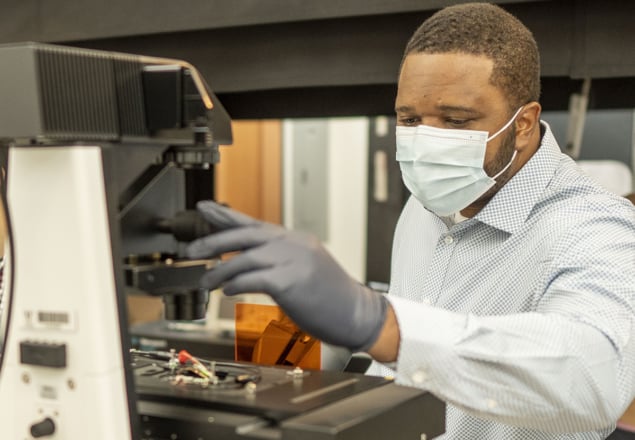Justus Ndukaife develops new ways of using light to manipulate nanoscale objects. He spoke to Margaret Harris about his research on plasmonic nanotweezers and their applications

How did you get interested in optical tweezers?
I’ve been passionate about electromagnetism since I was an undergraduate, and I also had an interest in nanotechnology. That was how I got started in nanophotonics, and specifically in plasmonics, which is an approach that enables us to confine and manipulate light on the nanoscale by exploiting interactions between electromagnetic waves and loosely bound electrons in metals. During my PhD, I learned that plasmonic structures, which are typically made of gold or silver, can be used to confine electromagnetic energy to very small volumes. That really rang a bell in my mind. Conventional optical tweezers trap objects at the focus of a laser beam, but the diffraction limit makes it challenging to focus light down to spot sizes less than about half the wavelength of light. That, in turn, limits the size of particles one can trap, and I could see that plasmonics might offer a way around this.
I quickly Googled “plasmonic tweezers” to see if anybody had done any work in the area. When I learned that they had, I began to think about what new contribution I could make. I realized that because the electromagnetic energy only extends a few tens of nanometres away from the surface of the plasmonic nanostructures, there is a challenge associated with the speed with which you can trap and manipulate particles using plasmonic tweezers. Typically, one has to rely on diffusion for particles to transport themselves randomly until they get close to “hotspots” in the electric field where they can be trapped. That’s a very slow process. It can take anywhere from several minutes to an hour before trapping occurs, depending on the concentration of the particles in the system.
In 2016 I published a paper (Nat. Nanotechnol. 11 53) that addressed that problem for the first time, making it possible to trap nanoscale objects with plasmonic tweezers in less than five seconds. In that paper, we showed that plasmonic tweezers not only have the ability to tightly grip nanoscale objects, they can also act as a really long “arm” to transport particles from tens or even hundreds of microns away.
What do these plasmonic nano-structures look like?
There are different geometries that can be considered, but one commonly used one is a nanopillar – basically a tiny cylinder that sits on a substrate. That cylinder forms an antenna, so when you shine light on a surface fashioned in this manner, you can easily sustain a dipole mode where you have two hotspots at the two extremities of the nanopillar. Other designs look like a bowtie or a double nanohole aperture, and they are both very efficient at squeezing light to extremely tight volumes.
What applications become possible once you’re able to manipulate nanoparticles more easily?
There are two broad areas. The first is in the life sciences, and it relates to nanosized particles called extracellular vesicles. We used to think that these particles were just a means for cells to expel waste, but in the last couple of years, scientists have discovered that they contain functional molecules like proteins, DNA, micro RNA and messenger RNA. These functional molecules can be used to encode information and communicate with neighbouring or distant cells, so they are very important for therapeutics and as a way to monitor the progression of diseases like cancer via what’s termed a liquid biopsy.
The challenge is that they are very, very small, and they are also highly heterogeneous both in their size distribution (anywhere from 30 nm to about 1 µm) and in their biogenesis. They all have different functions, too, and crucially, if you want to use them for liquid biopsy (an application my group is actively investigating), you need to be able to detect protein markers and RNA molecules contained in individual vesicles. This is a key area where optical tweezers and nanotweezers can deliver new functionality, because conventional approaches such as high-speed differential ultracentrifugation only work for bulk samples. They don’t allow you to analyse vesicles and markers at an individual level.
We are very interested in developing a platform that enables us to manipulate single photons for use in quantum photonics
The other interesting application area is in quantum photonics. The key to this emerging field is the creation of single photons and entangled photons using a non-classical light source, but it’s a challenge to do this in a way that’s compatible with established silicon chip technology and not too complex. Another drawback is that the photon emission rate of nanoscale quantum emitters is too low for most practical applications. That means we need to couple them to structures with a high photonic density of states, so that their emission performance can be enhanced. Hence, being able to manipulate these nanoscale emitters, some of which are below 30 nm in size, presents another opportunity for optical nanotweezers.
Since 2020 you’ve developed specialist nanotweezers for both application areas; what are these devices and how do they work?
The first is called an opto-thermo-electrohydrodynamic tweezer, or OTET. It’s a very cool device and we published a paper about it in 2020 (Nat. Nanotechnol. 15 908). The idea is that it’s incredibly difficult not only to trap sub-10 nm particles, but also to manipulate them. Regular optical tweezers cannot handle such small objects, and even plasmonic tweezers can only trap them right at a hotspot, where the temperature is high. That presents a challenge for delicate biological molecules like proteins or DNA. To keep those biological molecules intact, we needed a way to trap them away from high laser intensity, high-heat regions.
The way we do that with the OTET is to take a metal film and drill nanoscale holes in its surface. We then illuminate this structure with a laser such that some of the energy in the resulting plasmonic wave gets converted to heat. That produces a localized heating in an adjoining fluid medium, which in turn results in a temperature gradient in the fluid and a gradient in the fluid’s temperature-dependent properties such as electrical conductivity and permittivity. If we then apply an AC bias, we can induce electro-hydrodynamic flow in nanoparticles suspended in the fluid via the electrothermal effect. This electrohydrodynamic flow is basically a microfluidic vortex, and when you resolve it into its radial and axial components, you discover that the radial component is pointing inward.
The other effect involved in the OTET is called AC electro-osmotic flow. This phenomenon occurs because when we have this nanostructured metal film, and we apply an AC bias perpendicular to it, then in the region far away from the nanostructure, the electric field will be normal to the surface – that’s what Gauss’ law of electrostatics tells us. However, once you get close to the gold nanohole array, the field distorts so that there is a tangential component as well as a normal component. That tangential component can then act on the diffuse charges in the electrical double layer induced at the interface between the nanohole array and the fluid. When those charges move, they induce a fluid motion that carries the nanoparticle with them.
In OTETs, this AC electro-osmotic flow is radially outward, so we have a radially inward electrothermoplasmonic flow combined with a radially outward AC electro-osmotic flow. Together, these competing flows create a stagnation zone where the flow velocity falls to zero, and thus where the nanoparticle can be trapped. Once this trapping is established, we can then dynamically manipulate the particle simply by translating the laser beam. Crucially, the trapping zone is always several tens of microns away from the laser focus, which ensures that the particles never experience high laser intensity or photo-induced heating. The particles basically “feel” the ambient temperature, but you can still translate them from one position to another by moving the laser beam. It’s like action at a distance, something we might think of as science fiction, but we can make it happen in microfluidic chips.
What about the other device? I understand it’s designed to manipulate nanodiamonds with nitrogen-vacancy (NV) centres for quantum photonics applications.
This is our low-frequency electrothermoplasmonic tweezer, or LFET, which we described in a paper published in June 2021 (Nano Lett. 21 12 4921). Nanodiamonds with NV centres have been found to be very stable quantum emitters for quantum photonic applications because they do not experience photobleaching (that is, exposure to light does not chemically alter them in ways that would change their emission properties). Single NV centres also make good single-photon sources. But to have the emission properties needed for these applications, the nanodiamonds need to be coupled to photonic structures.

The LFET does this by leveraging an effect that is typically considered to be detrimental in plasmonics, which is that plasmonic structures dissipate heat. We use an AC electric field to induce an interaction between the nanoparticles and the plasmonic surface, which in this case is an array of gold nanopillars on a substrate. This interaction is very strong at low frequencies, and it enables us to trap single nanodiamonds. Then, when we illuminate a region of the gold nanopillars with light and apply an AC bias, we’re able to induce electro-thermoplasmonic flow to transport these nanodiamonds from several tens of microns away and position them close to the laser spot. Once they get close enough, they do experience some repulsive thermal force, but we’re able to mitigate that by using a low-frequency AC field.
The LFET enables us to move nanodiamonds from one region to another within seconds. In comparison, other approaches common to this area of quantum photonics, namely, the use of atomic force microscope (AFM) tips to pick up nanodiamonds and move them into position, are very tedious, taking up to or even more than an hour.
Optical nanotweezers allow us to analyse protein markers and RNA molecules contained in individual vesicles, which could help in the diagnosis of cancer
What’s the biggest obstacle you’ve had to overcome in developing these nanotweezers?
We’re an experimental group, even though we do a lot of computer modelling to understand the devices that we are designing or developing, and one of the key challenges we experience is in fabricating our nano-structures. Sometimes they don’t have the dimensions or morphology we need, and then we have to go back and re-do the fabrication. We often go through several iterations before we get all the parameters right. Once we’ve done that, though, the process becomes easier.
What’s next for you and your group?
With respect to quantum photonics, we are very interested in developing a platform that enables us to manipulate single photons. To that end, we are working to integrate nanoscale emitters with well-designed nanophotonic structures so that we can enhance single-photon emissions and route emitted photons on a chip.
For the biophotonics aspect, the key challenge we would like to address is to be able to analyse thousands of individual extra-cellular vesicles with very high throughput. This would be important both for our fundamental biological understanding of these particles and for the translational biomedical applications, which include liquid biopsies for non-invasive early disease diagnosis and monitoring patient response to treatment. An example might be certain kinds of cancer that are not accessible to conventional tissue biopsy techniques. It would be very beneficial if we could develop the capability to harness these vesicles, which are present in most bodily fluids (including blood plasma and saliva) to get information on the state of the cancer. That is something that will be very beneficial to society and will help to improve patient outcomes, and I believe there’s plenty of room for optical nanotweezers in this domain.



